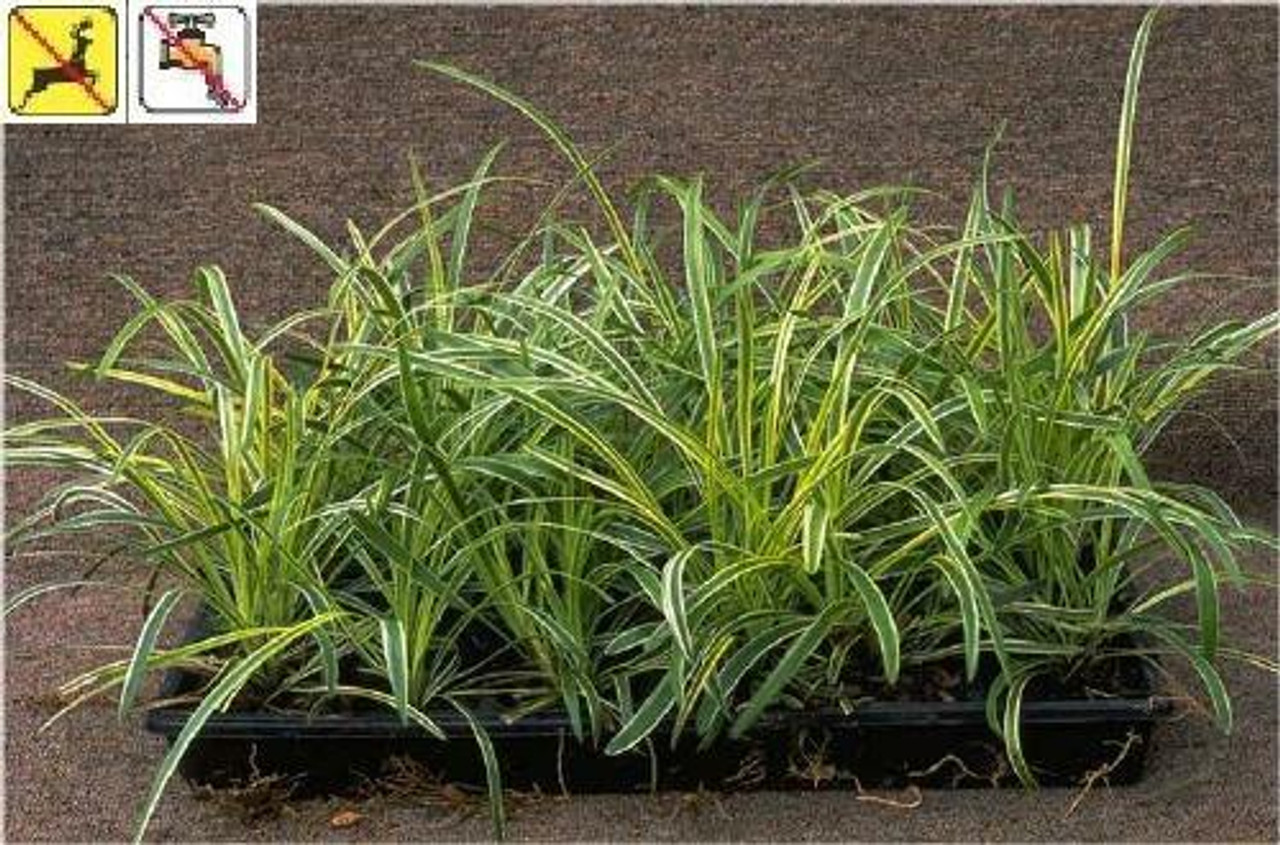Product Description
Liriope muscari 'Variegata' - Flat
Variegated Lilyturf, Border Grass, Blue Lilyturf
Zones 5 to 10; Full sun, filtered sun or deep shade.
Mature size 10 to 16 inches height forms a dense grass-like groundcover.
Liriope muscari 'Variegata', also known as Variegated Lilyturf, is a popular evergreen perennial that adds a touch of elegance and texture to gardens and landscapes. Its striking variegated foliage and delicate flower spikes make it a versatile choice for borders, groundcover, and container plantings.
- Foliage: Long, narrow, arching leaves with creamy-white stripes along the edges, creating a beautiful contrast against the green centers. The foliage remains attractive throughout the year, providing winter interest.
- Flowers: In late summer, it produces spikes of lavender-purple flowers that resemble grape hyacinths, adding a touch of color to the landscape.
- Growth Habit: Forms a clump that gradually expands, but it is not invasive like some other Liriope varieties.
- Height: 12-15 inches
- Spread: 12-18 inches
- Hardiness Zones: 5-10
- Light: Adaptable to various light conditions, from full sun to shade. It performs best in partial shade, especially in hot climates.
- Soil: Prefers well-drained soil but tolerates a wide range of soil types.
- Water: Drought tolerant once established, but benefits from regular watering during hot, dry periods.
Benefits:
- Versatile: Can be used as a groundcover, border plant, edging, mass planting, or in containers.
- Low Maintenance: Requires minimal care once established.
- Drought Tolerant: Can withstand periods of dryness, making it suitable for water-wise gardens.
- Deer Resistant: Generally unpalatable to deer and rabbits.
- Erosion Control: Its dense root system helps stabilize soil and prevent erosion on slopes and banks.
Growing Tips:
- Planting: Space plants 12-18 inches apart for groundcover or mass plantings.
- Watering: Water regularly during the first growing season to establish a strong root system. Once established, it can tolerate drier conditions.
- Fertilizing: Not generally required, but a light application of fertilizer in spring can promote growth.
- Pruning: Trim back old foliage in late winter or early spring to make way for new growth.
- Dividing: Divide clumps every few years to maintain vigor and prevent overcrowding.
If you are looking for a low-maintenance, evergreen perennial with attractive foliage and delicate flowers, Liriope muscari 'Variegata' is an excellent choice. Its versatility and adaptability make it a valuable addition to any landscape.
Eighteen (18) plants in 3.5-inch containers per flat (or tray).
Other Details
The most important part of the plant is its root system. Healthy roots are the foundation of a healthy, vibrant plant. The type of plug container used is based on the specific needs of the plants. Perennials offered as bare root traditionally perform better when planted as bare root.Planted in a specialized mix, potted plants have well established root systems. Top growth stage will vary depending on the current life cycle and time of year when shipped. In Winter and early Spring dormant plants may be shipped. Dormant plants may be planted right away, even before the last frost date.
Most bare root varieties are field grown for at least one season, though Hemerocallis and Hosta are grown for two seasons. The bulk of the soil is removed during the harvesting process and the tops of most varieties are trimmed back to the crown. They are graded, packed in shredded aspen or sphagnum moss and stored in freezers until ready to be shipped.
See our Container Sizes and Bare Root Perennials pages for more information.
Plant information and care is provided in the Overview section, Plant Genus Page and general information is provided in the Planting Care & Guides. Additional questions can be asked on each Plant page.
Plant Spacing: Using the maximum mature spread or width of a plant to guide spacing, ensures space to grow to full size. To fill an area sooner, plant them closer together. Just remember, future thinning or transplanting may be needed.
Water: Keep a close eye on newly planted perennials, especially throughout the first growing year. Most early plant loss is due to too much or too little water!






